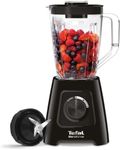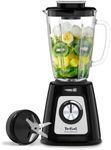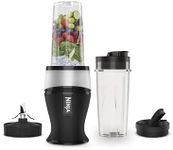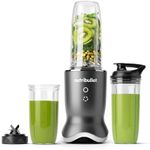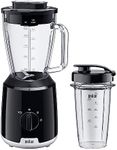Buying Guide for the Best Ice Crush Blender
Choosing the right ice-crush blender can make a significant difference in your kitchen experience, especially if you enjoy making smoothies, frozen drinks, or other recipes that require crushed ice. The key to finding the best blender for your needs is understanding the various specifications and how they impact performance. By focusing on these key specs, you can ensure that you select a blender that meets your requirements and delivers the results you expect.Power (Wattage)Power, measured in watts, indicates the strength of the blender's motor. This spec is crucial because higher wattage generally means the blender can handle tougher tasks, like crushing ice, more efficiently. Blenders typically range from 300 to 1500 watts. For crushing ice, a blender with at least 600 watts is recommended. If you plan to use the blender for heavy-duty tasks frequently, consider models with 1000 watts or more. Your choice should depend on how often and intensely you plan to use the blender.
Blade Quality and DesignThe blades are the components that do the actual crushing, so their quality and design are vital. Look for blenders with stainless steel blades, as they are durable and resistant to rust. Some blenders have specially designed blades for ice crushing, which can make the process more efficient. If you plan to crush ice regularly, opt for a blender with strong, sharp blades specifically designed for this purpose. If your use is more varied, a general-purpose blade might suffice.
Jar Material and CapacityThe jar material and capacity affect both the durability and the amount of ingredients you can blend at once. Common materials include plastic, glass, and stainless steel. Plastic jars are lightweight but can scratch and absorb odors. Glass jars are heavier and more fragile but do not retain odors and are easier to clean. Stainless steel jars are durable and retain temperature well but are opaque. Capacity typically ranges from 32 ounces to 72 ounces. Choose a jar size based on your typical batch size; larger families or frequent entertainers might prefer larger capacities.
Speed Settings and ControlsSpeed settings and controls determine how much control you have over the blending process. Blenders can have anywhere from 2 to 10+ speed settings. More settings allow for greater precision, which can be useful for different textures and consistencies. Some blenders also have pre-programmed settings for specific tasks like ice crushing, smoothies, or soups. If you want simplicity, a blender with fewer settings might be easier to use. If you enjoy experimenting with different recipes, more settings and pre-programmed options can be beneficial.
Durability and WarrantyDurability and warranty are indicators of the blender's longevity and the manufacturer's confidence in their product. A longer warranty period often suggests a more durable product. Look for blenders with at least a one-year warranty, though some high-end models offer warranties of up to seven years. Consider how often you will use the blender and for what purposes; if you plan to use it daily or for heavy-duty tasks, investing in a more durable model with a longer warranty can be worthwhile.
Ease of CleaningEase of cleaning is an important factor, especially if you plan to use the blender frequently. Some blenders have dishwasher-safe parts, which can save time and effort. Others have self-cleaning functions, where you add water and a bit of dish soap, then run the blender to clean it. Consider how much time you want to spend on maintenance. If convenience is a priority, look for blenders with easy-to-clean features.

